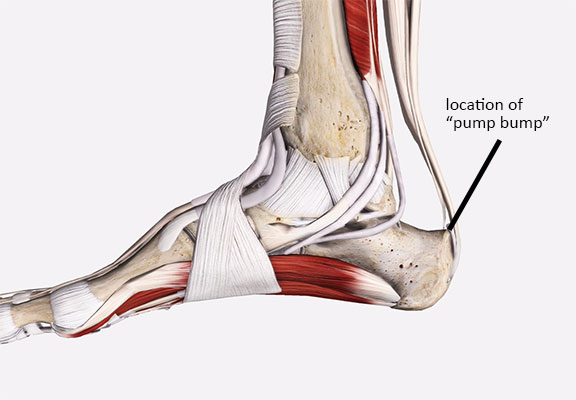What’s a Pump Bump?
- Whitney Lowe
What’s this bump on the back of my heel and why does it hurt so much? This is sometimes called a pump bump and is caused by several key mechanical factors. Let’s take a look…
The Achilles tendon is the largest and strongest tendon in the body. It has to be this strong because of the powerful contraction forces of the gastrocnemius and soleus (triceps surae) muscles. The triceps surae group is active in forward propulsion of the body during normal gait as well as being a primary decelerator of the body’s momentum when stepping down or landing from an elevated position. As a result there are strong tensile forces on the insertion of the Achilles tendon at the calcaneus.
The tendon is not the only tissue that may be adversely affected by the high tensile loads of the triceps surae, however. The retrocalcaneal bursa and the attachment site of the tendon into the calcaneus are other regions where high stress loads may be problematic, causing pain on the posterior aspect of the heel.
When a tendon attaches to a bone, the fibers of the tendon don’t just stop at the surface of the bone. These strong tendon fibers actually penetrate the surface of the bone so there is fibrous continuity of the tendon into the matrix of the bone structure. This gives the attachment site much more strength. However, if the tensile stress placed on the attachment site is too great, there may be breakdown in the structure of the bone at the attachment site and the body will attempt to repair the damage by adding more bony tissue. The additional bone that develops at this point of exaggerated stress is known as an exostosis or bone spur.
In the region of the Achilles tendon insertion into the calcaneus the high tensile loads can cause this same type of bone tissue breakdown and spur formation. The heel counter of the shoe will cause pain by pressing against the spur or the retrocalcaneal bursa that is just adjacent to the tendon insertion (see image). This posterior calcaneal spur is also frequently called a “pump bump” because the rigid heel counter of pump-style shoes put additional pressure on this area. The commonly used medical term for this spur is Haglund’s deformity.

Dr. Haglund was one of the first individuals to describe this spur along with a complex of problems that occur in the posterior heel region from Achilles tendon stress and pressure from the shoe. He called this collection of problems Haglund’s syndrome. Haglund’s syndrome is identified as a swelling in the posterior heel region that may include: retrocalcaneal bursitis, thickening of the Achilles tendon, a convexity of the soft tissues at the Achilles tendon insertion, and a prominent calcaneal projection. It is interesting to note that while retrocalcaneal bursitis is most often caused from excessive compression on the posterior calcaneus, there is an indication that repeated tensile stress at the insertion site of the Achilles tendon may cause bursitis as well.
Since strong tensile loads of the Achilles tendon appear to play a role in numerous foot and ankle complaints, there is a strong indication that soft tissue treatments like massage and stretching may be of significant benefit. However, keep in mind that many of these conditions have occurred from cumulative stress over time and therefore it may take a while to see the beneficial effects.

